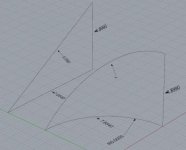David_M
Hot Rolled
- Joined
- Sep 30, 2014
- Location
- Midway, GA, USA
I know there are some good mathematicians on here. What is the length of the hypotenuse of the curved triangle (marked "x")? I can get it by letting the drawing program tell me or by treating it as a partial ellipse, other ways?
edit: It is hard to read the dimensions, they are: Side Adjacent: 7.854 ; Side Opposite: 4.899 ; Hypotenuse of the normal Triangle is: 9.2566 ; The Radius of the curved Triangle is: 5.000 ; and they are Right Triangles.

http://www.pbase.com/image/165865059/original
edit: It is hard to read the dimensions, they are: Side Adjacent: 7.854 ; Side Opposite: 4.899 ; Hypotenuse of the normal Triangle is: 9.2566 ; The Radius of the curved Triangle is: 5.000 ; and they are Right Triangles.

http://www.pbase.com/image/165865059/original
Last edited:




